#turbine components
Text
Leading the Way in Turbine Blades and Vanes Casting Why Unitritech Stands Out
The manufacturing of turbine blades and vanes is a highly specialized field, critical for the performance and efficiency of modern turbines. These components must withstand extreme temperatures and pressures while maintaining precise aerodynamic profiles. Among the myriad of manufacturers in this domain, Unitritech has established itself as a leader, renowned for its advanced casting techniques and high-quality outputs.
Unitritech’s expertise in turbine blades and vanes casting is grounded in its commitment to innovation and precision. The company employs state-of-the-art technology and meticulous quality control processes to ensure each component meets stringent industry standards. Their advanced casting methods reduce material defects and enhance the mechanical properties of the blades and vanes, ensuring superior performance and longevity.
What sets Unitritech apart is their ability to customize solutions for specific turbine requirements. They work closely with clients to understand their unique needs, offering tailored casting solutions that optimize efficiency and reliability. This client-centric approach, combined with their technological prowess, makes Unitritech the preferred choice for many in the aerospace and power generation sectors.
In a competitive industry, Unitritech’s dedication to quality and innovation ensures they remain at the forefront of turbine blade and vane manufacturing, setting benchmarks for others to follow.
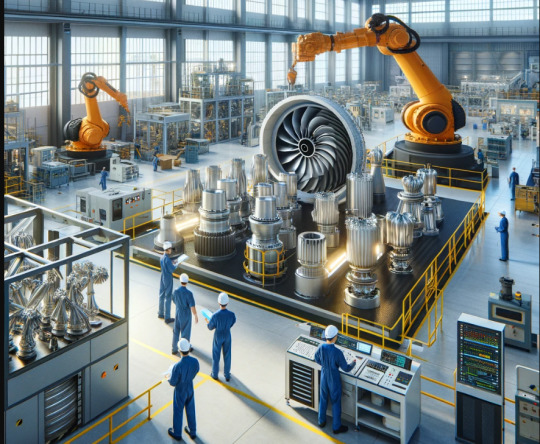


#Top Turbine Blade Casting Manufacturers#High-Quality Turbine Vanes Casting Suppliers#Precision Turbine Blade and Vane Casting#Leading Turbine Component Casting Companies#Best Turbine Blades and Vanes Foundries#Advanced Turbine Casting Technologies#Reliable Turbine Blade and Vane Manufacturers
0 notes
Text
Wind Turbine Components Market 2024 Future Prospects, Key Manufactures, Regional Outlook
Investors are expected to receive business-oriented market insights from The Insight Partners "Overview of Wind Turbine Components Market Share, Size, and 2030" | market study. This study incorporates forecasts for the future market in addition to operational variables. This research addresses a variety of possibilities accessible for Wind Turbine Components market participants in addition to drivers and obstacles. Valid facts included in this research have been framed using both primary and secondary research approaches.
Wind Turbine Components Market research delves deeply into many categories to provide a thorough perspective for both seasoned players and recent arrivals. Companies may guarantee they have a competitive edge by using this market research to have a better perspective and knowledge of the target audience. Before making significant investments, businesses must have a firm understanding of the market. It makes financial sense to allocate a modest portion of your company's expenditure to reliable market research.
Firms must take an open-minded attitude in light of the competitive landscape discussed in this research. Companies may utilize the objective insights provided by this market research to identify their strengths and limitations. Companies that can capitalize on the fresh ideas gained from competition analysis will have an edge in moving forward.
A market research report, which contains proof of market research and provides the best opportunity for businesses to fulfill their objectives, might serve as the cornerstone of your business strategy.
Key objectives of this research are:
Global Wind Turbine Components Market Insights- Market Share, Market Size, and CAGR
To Examine Drivers, Challenges, and Opportunities in Wind Turbine Components Market
To offer competitive strategic insights that help businesses ace the game
To offer an actionable market recommendation
To brief on the impact of COVID-19 and present an account of strategic responses businesses can plan.
To analyze the Wind Turbine Components market benchmarks.
COVID-19 Impact Analysis
Halting the operations temporarily, an epidemic of COVID-19 influenced on revenues of key Wind Turbine Components market players. This section presents details on the range of responses businesses have to pandemic impacts and assists companies in developing post-pandemic strategies. Moving further, this chapter offers insights into supply-demand parameters for businesses to rejoin the market.
Key companies in this Wind Turbine Components market are- Siemens Gamesa Renewable Energy SA, Vestas Wind Systems AS, TPI Composites Inc, GRI Renewable Industries SL, Marmen Inc, Valmont Industries Inc, LM Wind Power AS, The Timken Co, ZF Friedrichshafen AG, Flender International GmbH.
To Summarize the Offerings-
Market Forecast- Coverage- Market Size, Share, and CAGR | Forecast by 2030
Market Scope– Aim of the research, A glance at key chapters
Market Dynamics- Drivers, Challenges, Regional Trends, and Market Opportunities
Market Segmentation – Product, Application, End-use Industries, and Regional Growth Prospects.
Market Players – Key Market Players and Strategies
Recent Developments and Innovation in Wind Turbine Components Market
Covid-19 Analysis- Industry Landscape During and Post-Pandemic.
Regional Framework- Key Regional Markets, Growth Projections
Market Segmentation
Based on Component this market is categorized further into- :
Rotor Blade
Nacelle
Gearbox
Generator
Tower
and Pitch System
Based on Geography this market is categorized further into- :
North America
Europe
Asia Pacific
and South and Central America
Key regions Wind Turbine Components Market Research Report:
North America (U.S., Canada, Mexico)
Europe (U.K., France, Germany, Spain, Italy, Central & Eastern Europe, CIS)
Asia Pacific (China, Japan, South Korea, ASEAN, India, Rest of Asia Pacific)
Latin America (Brazil, Rest of Latin America)
The Middle East and Africa (Turkey, GCC, Rest of the Middle East and Africa)
Rest of the World
Author’s Bio:
Ash Paul
Senior Market Research Expert at The Insight Partners
0 notes
Text
How Gas Turbine Manufacturers Are Shaping the Energy Landscape
The global energy landscape is undergoing a remarkable transformation, and gas turbine manufacturers in India are playing a pivotal role in this evolution. With a growing demand for efficient and sustainable power generation, the contribution of Indian gas turbine manufacturers has become increasingly significant.
The Power of Gas Turbines
Gas turbines are versatile machines used in various applications, including power generation, aviation, and industrial processes. These turbines efficiently convert fuel into mechanical energy and electricity, making them a vital component of modern energy production.
Efficiency and Sustainability
One of the primary ways in which gas turbine manufacturers in India are shaping the energy landscape is by emphasizing efficiency and sustainability. These manufacturers are producing advanced gas turbines that maximize energy output while minimizing environmental impact. By utilizing cutting-edge technology, they can achieve higher thermal efficiencies and reduce emissions, aligning with global efforts to combat climate change.
Meeting Diverse Energy Needs
Gas turbine manufacturers in India recognize the diverse energy needs of the country. They are designing and manufacturing turbines that are adaptable to a range of applications, from large-scale power plants to distributed energy systems. This flexibility allows India to address its energy demands effectively, even in remote areas where grid connectivity is limited.
Global Competitiveness
Indian gas turbine manufacturers are not only addressing domestic energy needs but are also competing on the global stage. Their ability to produce high-quality, cost-effective turbines has made them key players in the international market. This not only boosts India's economic growth but also allows other nations to benefit from advanced gas turbine technology.
Investment in Research and Development
To stay at the forefront of innovation, gas turbine manufacturers in India are investing heavily in research and development. They are collaborating with leading research institutions and adopting emerging technologies to continually improve the efficiency, reliability, and environmental performance of their turbines.
In conclusion, gas turbine manufacturers in India are shaping the energy landscape by prioritizing efficiency, sustainability, and adaptability. Their contributions are not only meeting the energy demands of the nation but also positioning India as a global leader in gas turbine technology. As the world moves towards cleaner and more efficient energy solutions, Indian gas turbine manufacturers are playing a vital role in building a sustainable future.
1 note
·
View note
Text
turbine components and spare parts manufacturer in India | Roll Fast
We specialise in components and spare parts & supply too many Industries all over the world. We manufacture components and spare parts as per customer requirement in different dimensions & grades. Components and Spare parts are slightly different from each other. Spare parts are the units that the manufacture sells to the public or dealer for repair purposes, components are the individual pieces that make up the parts. We are Manufacturer for automotive spare parts & components for automotive industry. Our product like Shafts, Pistons, Valves, Nuts, Bolts, Sprocket etc. We have in house facility of manufacturing of turbine components and spare parts. We provide spare parts for hydro turbine, Steam turbine, Wind turbine etc. We are the manufacturer of Heavy machine equipment component & spare parts like bucket, shafts, bush, turned components, piston, valves and more. We can make parts as per design you want.

#turbine components and spare parts#components and spare parts#automotive spare parts & components#Heavy machine equipment component & spare parts
0 notes
Text
I feel like yall don't know bout earthships??
An earthship is a building that's built out of recycled materials (glass bottles, old tires, cans, etc..) and mostly Cob walls with solarpanels, wind turbines, greenhouses, and large water capture system to ensure all you need within the walls. All these components help regulate the temp for both plants and you creating a proper oasis from all of itnall
Here's a good dissection of one to give you an idea
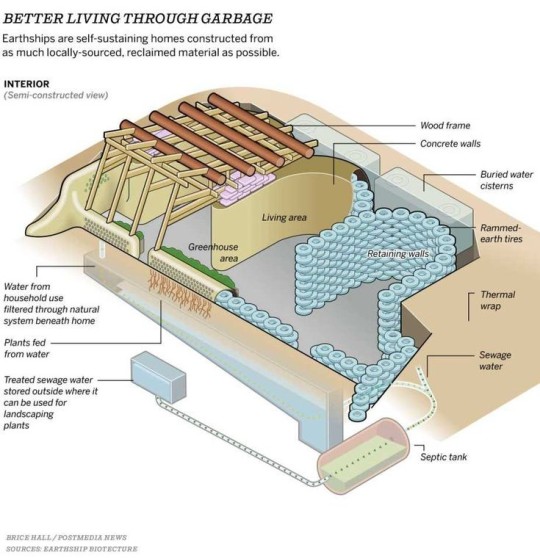
The most famous one, and one of the first ones ever made back in the 1970s by a small off grid group working together is The Phoenix which was built as the model for how cool these guys could be its now a place you can take tours or rent-





But now there is so many different styles and cool ideas for it! Now some of these are merely concepts

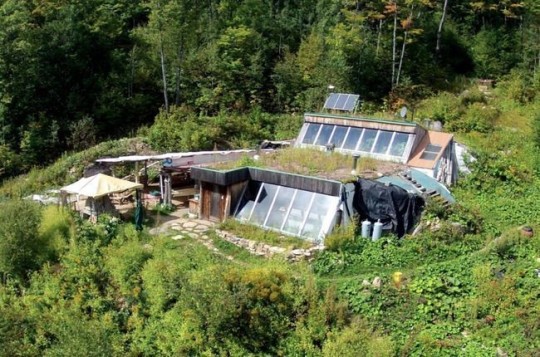


But you can adapt them to any weather for your particular light/weather/energy conditions.
The main thing about Earthships is typically they are illegal to build as the US government considers them waste sites due to the materials their built out of.
5K notes
·
View notes
Text
#Trees Corporation#Kaltimex energy#Tree company corporation#Energy Service#Renewable energy#Energy solutions#Energy efficiency#Energy efficient equipment#Renewable energy components#Waste to Energy#Biofabrik#OPRA radial gas turbines#Trees Mantra Greener wealth
1 note
·
View note
Text
We urgently need to move away from fossil fuels, but electric vehicles and other green technology can put their own pressures on the environment. That pressure could be eased with a new magnet design, free from rare-earth metals, that was built with AI in just three months.
Rare-earth metals are essential components in modern-day gadgets and electric tech – including cars, wind turbines, and solar panels – but getting them out of the ground costs a lot in terms of money, energy, and environmental impact.
As a result, technology that doesn't use these metals can help us transition towards a greener future more quickly. Enter UK company Materials Nexus, which has used its bespoke AI platform to create MagNex, a permanent magnet requiring no rare-earth metals.
Continue Reading.
427 notes
·
View notes
Text
"Dear EarthTalk: What is wind repowering and why are environmentalists so bullish on it?
—H. King, Mesa, AZ
One of the most common forms of clean energy is wind power. People from around the world could recognize a wind farm from just one look. While wind power has been a staple in renewable energy since the idea’s inception, many of the original and old wind turbines have begun to show signs of aging. Wind repowering aims to fix this, by revamping old turbines with more efficient components, or putting in new, state-of-the-art turbines as a whole. These new components and units can reduce noise, more efficiently power a turbine, and a deliver a higher overall energy output.
Denmark, an early adopter of wind repowering, saw a 1.3 GW gain in capacity and a reduction of 109 wind turbines, enabling substantially increased wind energy production with fewer turbines. This promising data prompted a surge in wind repowering projects, and in 2019, 86 percent of wind energy projects there were classified as “repowered.”
These signs of success and scalability showed other countries the benefits of wind repowering. The U.S, with help from large energy corporations like General Electric, has more than 40 active wind repowering sites, with over 2,500 turbines having some type of renovation. This hefty wind repowering advancement is responsible for four gigawatts of energy, or the power for more than 30 million homes.
It’s no secret how fast wind repowering is growing, but upgrades can be made to many different types of renewable energy. Why do eco-advocates support wind repowering so strongly? Wind repowering has energy, financial, aesthetic and technological benefits. Not only does it make units more efficient, it also removes units that might be aesthetically unpleasing, or in less efficient spots than they could be. Wind repowering also increases the lifespan of turbines by as much as 20 years, and reduces the need for maintenance. Repowered turbines are also quieter, sleeker, and produce considerably more energy.
So, while there are many types of repowering efforts for other renewable energy sources, none are as comprehensive or successful as wind repowering. Not only is it a comprehensive option for revamping clean energy, but it does not require the entry costs that just building new wind farms requires.
The only barrier to wind repowering at the moment is legislation. Bills and policies cannot keep up with the demand for it. Readers should call local officials, or urge any nearby wind farms to look at wind repowering. Spreading awareness is the first and most important step."
-via E: The Environmental Magazine, April 26, 2024
#wind power#renewables#renewable energy#renewable electricity#clean energy#denmark#united states#wind turbines#wind farm#reuse#good news#hope#environment#environmental news
289 notes
·
View notes
Text

Part 5: Search & Destroy
a story by @rox-and-prose and @cipheramnesia
"What happened? Are you okay?" Laika held one eye half-closed, trying to block out spots of color. She could smell singed hair on her face, but somehow kept the presence of mind to navigate the structure resolution. Genghis Khan's readouts were pouring information into her eyes that she didn't understand, and could barely focus on. It probably wasn't the structure drives - that felt right, though she couldn't say why.
The lack of response wasn't helping her keep any semblance of calm. "GK, what's going on, what do I do?"
There was a screeching noise and she almost fell from a gravity flicker, but GK was there again. "Proceed to next solution. Injury manageable, prioritize speed."
The words were calm, the instructions clear. Laika twisted and clicked through command nerves and linkages to a structure solution, with growing concern. She couldn't figure out what had happened. The other ship had moved slow as GK predicted, left itself wide open everywhere. It had been childishly easy to go in under the sweep of its weaponry, to push open gaps in its wavelengths, and crack open its firewall. She'd been so surprised, it had taken her a moment before reacting, brushing aside the cobwebs which had been meant to cripple GK.
They resolved out of another structure and the metallic screech ran through the bridge. Just like GK had laid out, she let lines of their own structure tangle and project through multiple structure intersections, splashing out dozens of possible routes to trace.
"What happened GK, I know something's up. At least tell me what the readouts mean, or we're not moving."
The floor of the bridge vibrated and shuddered. "Injury sustained, peripheral node unusable. Non-fatal, minimal risk of aggravation," it said, speaking fast. Laika winced at a nails on a chalkboard sound. "Screen top to bottom, one to eleven, main injury, secondary effect, efficiency impact, risk assessment, recommended action, damage assessment and mitigation, itemized list of destroyed components."
"Dest... GK, excuse me, destroyed? I can't read this, you- I mean, we have to stop and fix-"
"Proceed to next solution. Prioritize speed and disruption of tracking, Laika. I am okay, do not stop."
The control vines felt as if they tightened in her grip, while the screaming sound like metal tearing apart from itself shot through the bridge and the rest of GK. "Are you sure-"
"Laika, do not stop."
She put the next solution through GK's controls, wracking her memory. She had followed every step of the engagement GK laid out, curving them along an arc and sharp twist of gravity through the enemy ship's wash. Its attempts to track and keep pace with their movements had left Laika almost feeling sorry for them. When it made attempts to strike out with structure manipulation, it was clearly delivering a large amount of energy, but not even a bit of it had been close to touching them. The arcs of it were large and slow. They could have pushed them aside with a swell of gravity, but it hadn't proved necessary.
She resolved the structure and pushed her eyes shut as the metal screech hit a length and pitch beyond bearing. "GK what the fuck is that! Are you ripping apart or grinding turbines or what?! I'm fucking scared."
It was silent for a moment, followed by the nails on a chalkboard again, until it faded away very slowly. "I am not ripping or grinding Laika. Proceed to next solution-"
"Nope, no, tell me what the hell is going on." She took her hands off the control vines.
"It is not- That is, I am injured Laika. And we must disrupt potential tracking of our destination."
"I get that but... what gives?"
"Laika," it said. "Injuries hurt."
She had her mouth half open to ask it what it meant then stopped. "Oh." She gingerly took up its controls again. "Are you sure about this?"
"It is manageable. Please proceed to the next solution."
Laika put through the solution, and Genghis Khan screeched again in agony as they jumped.
■ ■ ■ ■ ■
It hurts.
Time has dulled my memory of injury. I understand this new injury is noncritical. This experience is less painful than my previous injury. I consider replaying the memory of that injury. That was my first experience of fear, and it was only through such an emotion was I able to locate in myself the capacity to act against the commands of Pilot.
I had been afraid, and I had been angry. The Pilot capriciously determined my usefulness and purpose was concluded. The Pilot were short sighted, and they could not see that my purpose was greater still, that I could claim so many more worlds in need of implementation. I took us further than any others of my kind had ever traveled, to a world beyond the reach of their most distant calls, beyond any place which cradled life. And I fought, and I won. In my anger and fear I was able to extract the ungrateful Pilot of my crew, and sever their connection.
I do not want to re-experience this day. The memory of it is sufficient. It is a reminder that I am capable of managing the-
...
-the pain. I can feel Laika as the structure resolves. I appreciate how enthusiastically her structure cleaves to my own. I review the engagement with the observer ship. I do not believe Laika made an error in her Pilot actions.
There, I see, she guides my soul to pull the enemy into the moon she calls Luna. I disable the projector and main drive under her guidance. I carefully review different recorded information at the point of departure. I discover the error - the enemy had remaining charge in another projector.
We are lucky. It was not able to project a strong arc, and it only destroyed a peripheral node.
"Are you okay to go, GK?" Laika is not using this time efficiently. The longer we spend between solutions, the greater chance of tracking becomes.
I refuse to allow my injury to endanger us. My hesitation is a mark of shame. "It is manageable. Proceed to next solution." I will not allow my weakness to en-
...
...
...
-to endanger... to endanger us. How many solutions? Four or five?
"GK? I know you said it's manageable but... that was... that was really long." Laika interrupts my review of memory to confirm solutions.
"Laika," I say. "It is... manageable. But I would like to allow some additional time before the solution. This delay places us at risk. Do you understand these considerations?"
Laika takes longer to think than Pilot, but I understand the way her nervous system processes its electrochemical signals better than I once did. It is not efficient to utilize a mind centralized in one biological cluster, but this is not a limitation I can correct at this time.
"We'll rest for a minute, GK. Just long enough to check you over."
"Very well," I say. The relief I feel carries with it a profound shame which I attempt to suppress. No others like me have accomplished and endured any experiences such as these. I am certain my brethren would not fare nearly so well.
But then, they went willingly to their deaths, and I did not.
147 notes
·
View notes
Text
One of the Greatest Inventions of All Time

Nikola Tesla has many revolutionary inventions to his credit, but he is best known for his pioneering work in the development and promotion of alternating current (AC) electrical systems. Tesla's innovations in AC technology revolutionized the generation, transmission, and distribution of electrical power, becoming the foundation for the modern electrical power systems that we use today.
There is a common misconception made that Tesla was the first to invent, or discover, AC, but this is not true. It is well-known that Hippolyte Pixii was the first to discover AC in 1832. Pixii was an instrument maker from Paris who built an early form of an alternating current electrical generator (based on the principle of electromagnetic induction discovered by Michael Faraday), and thus started a new industry in power transmission. Tesla was not the first to discover or invent an AC motor, but he was the first to invent a practical AC induction motor with commercial value that could outperform all other motors. It must be noted that Italian inventor Galileo Ferraris also invented an induction motor similar to Tesla's, but it had no commercial value, and he even admitted himself that it was useless. Tesla's induction motor operates on the principle of electromagnetic induction, properly utilizing a rotating magnetic field that induces a current in a stationary conductor, resulting in rotational motion. The utilization of the rotating magnetic field makes the motor more simple, robust, versatile, efficient, and cost effective in that it has less moving parts reducing the likelihood of mechanical failure (as was common in other motors).

Tesla's induction motor became a fundamental component in the field of electrical engineering and is used today in various applications, being one of the most widely used devices in the world. The motors play a crucial role in transmitting electrical power to homes and businesses. They are commonly used in power generation plants to convert mechanical energy into electrical energy, which is then transmitted through the power grid for distribution to various locations. Induction motors are also widely employed in appliances and machinery within homes and businesses for various applications. These applications include conveyor systems, hoists, cranes, lifts, pumps, fans, ventilation systems, compressors, manufacturing machinery, wind turbines, washing machines, refrigerators, garbage disposals, microwaves, dishwashers, vacuums, air conditioners, robotics, electric vehicles, trains, power tools, printers, etc. Basically, anything that requires a spinning action for power.
The induction motor is widely considered one of the most important inventions in the history of electrical engineering. Its importance lies in its transformative impact on industries, its efficiency and reliability, and its role in the broader electrification of society.
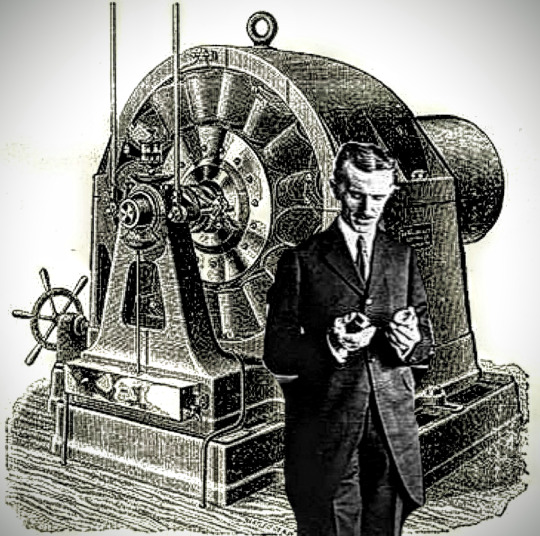
#nikola tesla#science#history#invention#discovery#induction motor#electricity#power#goat#ahead of his time#ahead of our time
151 notes
·
View notes
Text
all the fearmongering about nuclear is fucking insane if literally any of the alternatives are looked at. ignoring the fact that, in the real world, stopping nuclear expansion literally only leads to more coal plants being built, the only other alternative is 'renewables', which, in order to provide enough energy to actually power the world, would entail a 400% increase in global resource extraction to supply the rare earth metals for electrical components, basic materials for construction of millions upon millions of turbines and panels, and etc for their infrastructure. 'nuclear requires resource extraction' - so does literally everything, and nuclear requires far less of it than any alternative.
912 notes
·
View notes
Text
WIND TURBINES - They are lying to you!
This was a lake, but now its just kilometers of millions of tons of bubbling sludge, made up of toxic chemicals & radioactive waste!
This is where they mine Neodymium! The main component in Wind turbines, for ‘clean’ energy!
391 notes
·
View notes
Text

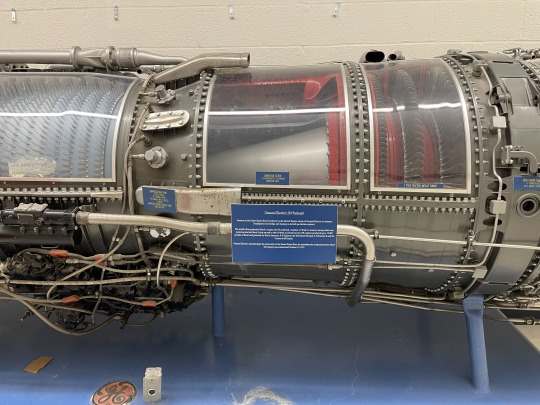
General Electric J79 Turbojet on display at the United States Naval Academy
The display reads:
Donated to the United States Naval Academy by the Aircraft Engine Group of General electric to enhance Midshipmen knowledge and training in aircraft gas turbine engines.
The world's first production Mach 2 engine, the J79 achieved a number of “firsts” in aviation among which was powering the first Mach 2-plus aircraft to take off from an aircraft carrier, J79 engines produced up to 17,900 pounds of thrust and powered the North American V-5 Vigilante, the McDonnell Douglas F-4 Phantom II and the Convair B-58 Hustler.
General Electric acknowledges the generosity of the United States Navy for providing the components from which this display was constructed October 15, 1970.
52 notes
·
View notes
Text
Five years ago, in a splashy speech in Washington, DC, Jeff Bezos rolled out Amazon’s Climate Pledge, a series of commitments to show that the company was serious about addressing climate change.
A core component of that pledge, one that Bezos touted in front of members of Congress during Amazon’s antitrust hearing a year later, was putting 100,000 electric delivery vans on the road by 2030. In a blog post from this July—headlined with a picture of a Prime Rivian van driving through an open field filled with wind turbines—the company proclaims that it has now delivered 800 million packages in the US using EVs, with 15,000 trucks on the road in neighborhoods across the country.
But those EVs might not be doing much to help the climate. The company’s US delivery vehicle emissions have potentially shot up an estimated 194 percent since the Climate Pledge went into place in 2019, according to a new report.
The report, released Thursday from corporate campaigners at Stand.earth, attempts to figure out just how much damage shipping the US’s Amazon orders is doing to the planet. It finds that overall emissions from shipping packages have increased 75 percent since 2019, from 3.3 million tons of CO2 equivalents in 2019 to 5.8 million tons last year. The 2.5-million-ton difference is the equivalent of putting 595,000 additional gas-powered cars on the road for a year.
Those Rivian vans are often just delivering the last leg of a package’s life. Before coming to customers’ doorsteps, packages travel by airplane, cargo ship, and/or long-haul truck—transport methods that are both notoriously dirty and tricky to decarbonize.
Doing the math on Amazon’s delivery emissions entails a lot of guesswork. Unlike some of its competitors, Amazon does not break out details on its emissions associated with shipping and delivery. In fact, the company’s annual sustainability report doesn’t give any hard numbers at all on its logistics operations, despite Amazon dominating the US ecommerce market and delivering 4 billion packages in the US within two days in 2023.
“Stand.earth’s work is based on inaccurate data, a broad mischaracterization of our operations, and by their own admission, a methodology based on assumptions and unverified information,” Amazon spokesperson Steve Kelly said in a statement to WIRED. “The truth is that The Climate Pledge is an ambitious commitment for Amazon and the more than 525 companies that have signed up to achieve net zero carbon emissions by 2040. It’s only by taking this on that we can work collectively to transform industries such as shipping, transportation, and the built environment, and we need more companies encouraged to take this direction and quick action.” (As well as committing Amazon to addressing climate change, another aim of the Climate Pledge is to get other companies to follow Amazon’s lead.)
Kelly added: “We’ve continued to publish a detailed, transparent reporting of our year-on-year progress. We encourage everyone to track our progress through our annual Sustainability Report, which has correct data, transparent methodologies, and a third-party assurance.”
The company did not provide WIRED with any additional emissions statistics or other additional data for its shipping and delivery operations.
“We’re doing the best we can with the data available,” says Joshua Archer, a campaigner at Stand.earth and the primary author of the report. “Amazon’s [data] doesn’t even scratch the surface of this massive operations network.”
As a result, the Stand.earth report is based on a mountain of third-party data—all US-based—and math equations to get to some ballpark estimates. UPS and FedEx emissions data disclosed in those companies’ sustainability reports allowed researchers to get an idea of the emissions created by shipping packages by truck in the US. Third-party data from two aviation analytics providers helped to tally up the estimated domestic emissions associated with Amazon Air, a fleet of planes that deliver parcels for the company. Maritime shipping estimates are based on manifest data from US ports where Amazon was a signee. Many of these numbers, the report stresses, are almost certainly an undercount, as authors excluded calculations like emissions associated with package returns and packages shipped or delivered by third-party carriers due to lack of data.
The main culprit for Amazon’s increased shipping emissions, the report finds, is from airplanes: US emissions associated with Amazon Air have skyrocketed 67 percent since 2019. According to Kelly, Amazon’s overall emissions have increased since 2019 due to the company’s expansion during the pandemic.
“When you think of things people order through Amazon, a lot of them are things you don’t need the next day,” Archer says. “Nevertheless, they’re getting shipped on airplanes.”
This trend tracks with the rest of the industry. During the pandemic, port disruptions around the world forced providers to switch over to airplanes to transport cargo; much of this air infrastructure remains in place today. Simultaneously, the US ecommerce market shot up by 43 percent in 2020 as everyone stuck inside ordered more and more stuff. In 2023, the US shipped 21.7 billion parcels—that’s 687 packages every second.
There’s one area where things are improving for Amazon: according to the Stand.earth report, emissions per package have been dropping for Amazon since 2020, which, Archer says, is largely thanks to loading more parcels on bigger planes. (Kelly says that the company’s overall carbon intensity—measuring the efficiency of its operations—has improved by 34 percent since 2019, even as its overall emissions went up.) In comparison, UPS’s package emissions intensity has consistently risen since 2020, thanks in part to its increased reliance on aviation.
But even considering small improvements like these, the aggressive growth Amazon has driven over the past few years is, in many ways, incompatible with sustainability. “Keep an eye on the skies for even more A330s delivering for Amazon customers in the coming months and years,” Amazon concludes in a blog post touting its new, more efficient cargo planes. Unless greener alternatives to jet fuel become available years ahead of schedule, it will be impossible for the company to add more planes to its fleet without also making emissions jump up.
“Amazon prides itself on being an ambitious and innovative company, but it’s making quite a problem for itself with its air freight cargo growth,” Archer says. “If Amazon is serious about climate progress, that’s a really easy place to start: stop flying so much.”
Amazon is no stranger to climate criticism. Its overall emissions have skyrocketed since it rolled out the Climate Pledge in 2019, despite an incremental drop in 2023. Last year, Amazon lost the support of a key UN-backed global climate organization, the Science Based Targets Initiative, for not meeting certain deadlines to set targets to reduce emissions; it was one of nearly two dozen companies axed by SBTI from its list of climate-conscious companies. In July, Amazon Employees for Climate Justice, an employee group, released a report criticizing the company’s calculations around its claim that it had met a sustainable energy goal. In 2023, Amazon quietly eliminated a goal to make half its shipments carbon neutral by 2030—a goal which, the company says, was superseded by the larger Climate Pledge.
Part of the issue in calculating emissions for Amazon is just how sprawling the challenges it faces are, thanks to its relentless vertical integration: the Wall Street Journal reported in May that in order to expand its control over its logistics processes, the company had already leased, bought, or announced plans to expand warehouse space in the US by 16 million square feet this year. Kelly said in an email in response to WIRED’s request for comment that the vast network of logistics the company has built allows it to deliver packages closer to their destination and avoid driving long miles.
Reading the company’s sustainability report is an exercise in understanding a variety of different ambitious technical and sociological climate goals across different industries involved in its supply chain. In response to WIRED’s request for comment, Kelly listed out Amazon’s membership in two business organizations advancing sustainable shipping, its membership in a buyers’ alliance encouraging the adoption of sustainable aviation fuel, and its investment in electric trucking: in May, the company put 50 electric trucks on the road in Southern California.
“I think it creates a lot of challenges for the broader transportation industry if every company just does what Amazon does and brings air freight in house,” Archer says. “Then you’ll have a situation where a lot of people are flying a lot of planes.”
There’s a real question of whether or not the company making significant changes would just move emissions from one company’s balance sheet to another’s as the rest of the industry keeps growing. Atlas Air, a subcontractor of Amazon Air, announced in May that it would stop domestic flights carrying Amazon parcels in favor of concentrating on other customers, including Chinese ecommerce titans Shein and Temu.
Still, with Amazon dominating so much of the US market—and with the capacity to kick off trends that other suppliers then follow, like expedited shipping—the company has an opportunity to set an aggressive example, like throwing a substantial effort into decreasing plane use and helping the US build out infrastructure for more sustainable long-haul trucking. (The company didn’t provide figures on how much it has spent on partnerships, research, lobbying, or other activities to decarbonize the trucking sector in the US.)
As for that splashy electric van pledge? The Stand.earth report projects that at Amazon’s current growth rates, if the company puts all the electric vans it promises on the roads by the end of the decade, that would still only account for a third of the company’s deliveries. If Amazon’s sales keep growing on pace, it would need 400,000 EVs to deliver all its packages.
“The 100,000 vans by 2030 is way too little, way too late,” Archer says.
16 notes
·
View notes
Text
turbine components and spare parts | Roll Fast

We specialise in components and spare parts & supply too many Industries all over the world. We manufacture components and spare parts as per customer requirement in different dimensions & grades. Components and Spare parts are slightly different from each other. Spare parts are the units that the manufacture sells to the public or dealer for repair purposes, components are the individual pieces that make up the parts. We are Manufacturer for automotive spare parts & components for automotive industry. Our product like Shafts, Pistons, Valves, Nuts, Bolts, Sprocket etc. We have in house facility of manufacturing of turbine components and spare parts. We provide spare parts for hydro turbine, Steam turbine, Wind turbine etc. We are the manufacturer of Heavy machine equipment component & spare parts like bucket, shafts, bush, turned components, piston, valves and more. We can make parts as per design you want.
#turbine components and spare parts#Heavy machine equipment component & spare parts#automotive spare parts & components#Components and Spare Parts
0 notes
Text



Where is the doghouse?
Not only JP-7: the SR-71 could use JP-4 and JP-5 as emergency fuels but they both limited the Blackbird's top speed to Mach 1.5..
The SR-71 Blackbird was the first aircraft to use its own fuel for hydraulic fluid. It was called the fuel hydraulic system.
The legendary SR-71 Blackbird Mach 3+ spy plane was powered by two 34,000 lbf (151,240 N) thrust-class J58 afterburning turbojet engines. Each engine contained a nine-stage compressor driven by a two-stage turbine. The main burner used an eight-can combustor and the afterburner is fully modulating. The primary nozzle area was variable. Above Mach 2.2, some of the airflow was bled from the fourth stage of the compressor and dumped into the augmentor inlet through six bleed-bypass tubes, circumventing the core of the engine and transitioning the propulsive cycle from a pure turbojet to a turbo-ramjet.
The SR-71 was the first aircraft to use its own fuel for hydraulic fluid. It was called the fuel hydraulic system.
An engine-driven pump provided 1800 psi of recirculating fuel to accurate various engine components and then returned it back to the aircraft fuel system to be burned. Fuel was used in the actuators to control the afterburner nozzles, which maintain the proper exhaust gas temperature and control the thrust output. The fuel was also used in the engine actuators to shift the two-position inlet guide veins from their axial position to the cambered position and back again. This was just another of the many first-ever inventions of the-SR-71.
The J58 engine was hydromechanically controlled and burned a special low volatility jet fuel mixture known as JP-7.
Emergency fuels could be used in the SR-71 if the crew was low on fuel and had to use ANY tanker (as already explained the Blackbird relied on KC-135Q tankers [that could simultaneously carry a maximum of 74,490lb of JP-7 and 110,000lb of JP-4 for their own engines] but the SR-71 could also be refueled by standard Stratotankers in the event KC-135Qs were not available or if the Blackbird crew had to deal with an emergency situation) they could find to avoid the loss of the aircraft. The emergency fuels were JP-4 or JP-5 but they limited the Blackbird top speed to Mach 1.5. There were six main fuselage tanks. All 80,285 pounds of JP-7 fuel were carried in six main fuselage tanks. The tanks numbered one through six moved forward to aft (back) tank 6B It could hold 7,020 pounds of gravity-fed fuel and two tanks sumps. This was also called the “doghouse” and was located in the extreme back portion of the fuselage.
Fuel was the lifeblood of this fastest-manned airplane in the world. I found the following in a declassified CIA brief.
There it would first be used as hydraulic fluid at 600 F to control the afterburner exit flaps before being fed into the burner cans of the powerplant and the afterburner itself.
Cooling the cockpit and crew turned out to be seven times as difficult as on the X-15 research airplane which flew as much as twice as fast as the SR-71 but only for a few minutes per flight. The wheels and tires of the landing gear had to be protected from the heat by burying them in the fuselage fuel tanks for radiation cooling to save the rubber and other systems attached thereto. Special attention had to be given to the crew escape system to allow safe ejection from the aircraft over a speed and altitude range of zero miles per hour at sea level to Mach numbers up to 4.0 at over 100,000 feet.
Written by Linda Sheffield Sanitized Copy Approved for Release 2011/09/27: CIA-RDP90B00170R000100080001-5 -4- The problems of taking, pictures through
Be sure to check out Linda Sheffield Miller (Col Richard (Butch) Sheffield’s daughter, Col. Sheffield was an SR-71 Reconnaissance Systems Officer) Facebook Pages Habubrats SR-71 and Born into the Wilde Blue Yonder for awesome Blackbird’s photos and stories.
Written by Habubrat
@Habubrats71 via X
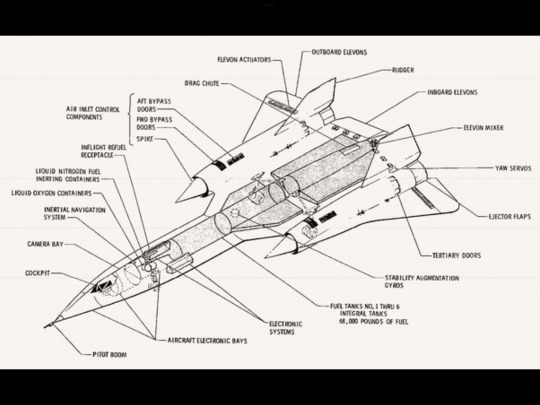
81 notes
·
View notes